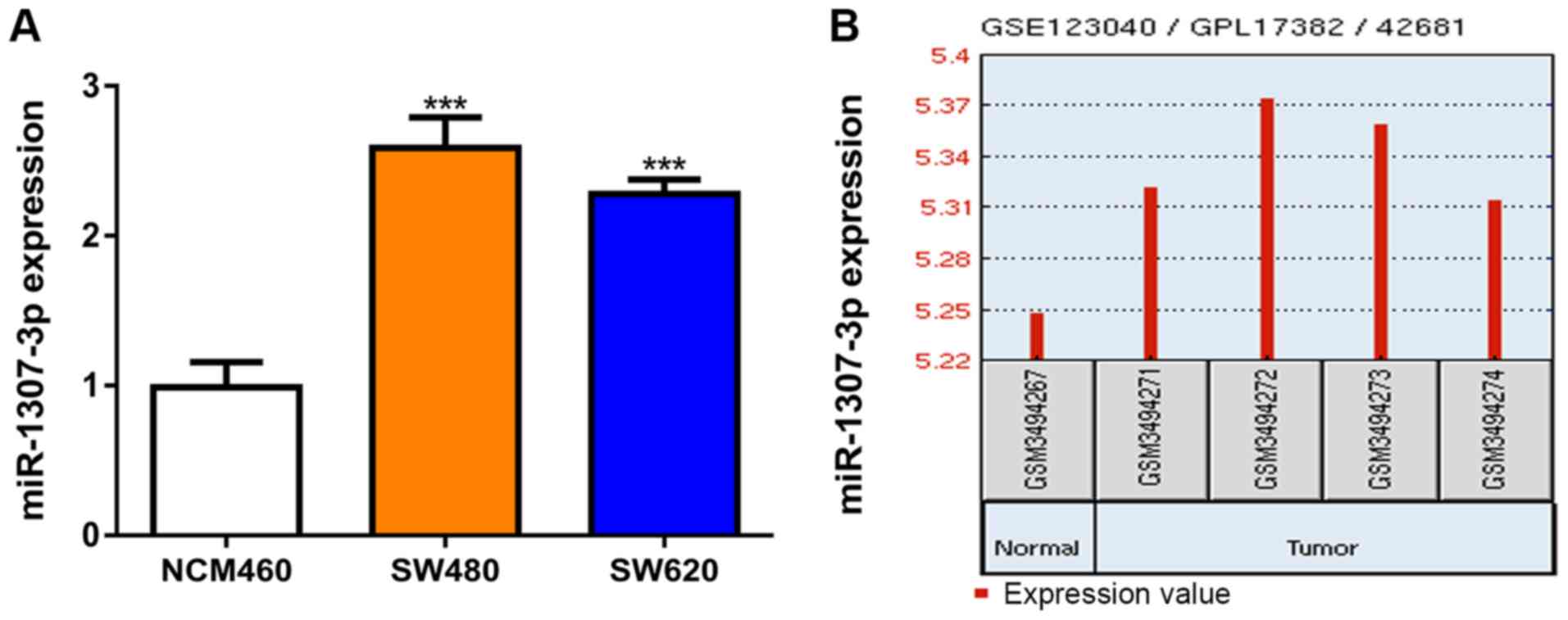|
1
|
Ferlay J, Soerjomataram I, Dikshit R, Eser
S, Mathers C, Rebelo M, Parkin DM, Forman D and Bray F: Cancer
incidence and mortality worldwide: Sources, methods and major
patterns in GLOBOCAN 2012. Int J Cancer. 136:E359–E386.
2015.PubMed/NCBI View Article : Google Scholar
|
|
2
|
Chen W, Zheng R, Baade PD, Zhang S, Zeng
H, Bray F, Jemal A, Yu XQ and He J: Cancer statistics in China,
2015. CA Cancer J Clin. 66:115–132. 2016.PubMed/NCBI View Article : Google Scholar
|
|
3
|
Popat S, Hubner R and Houlston RS:
Systematic review of microsatellite instability and colorectal
cancer prognosis. J Clin Oncol. 23:609–618. 2005.PubMed/NCBI View Article : Google Scholar
|
|
4
|
Bartel DP: MicroRNAs: Genomics,
biogenesis, mechanism, and function. Cell. 116:281–297.
2004.PubMed/NCBI View Article : Google Scholar
|
|
5
|
Huang C, Liu J, Xu L, Hu W, Wang J, Wang M
and Yao X: MicroRNA-17 promotes cell proliferation and migration in
human colorectal cancer by downregulating SIK1. Cancer Manag Res.
11:3521–3534. 2019.PubMed/NCBI View Article : Google Scholar
|
|
6
|
Ding X, Du J, Mao K, Wang X, Ding Y and
Wang F: MicroRNA-143-3p suppresses tumorigenesis by targeting
catenin-δ1 in colorectal cancer. Onco Targets Ther. 12:3255–3265.
2019.PubMed/NCBI View Article : Google Scholar
|
|
7
|
Han S, Zou H, Lee JW, Han J, Kim HC, Cheol
JJ, Kim LS and Kim H: miR-1307-3p stimulates breast cancer
development and progression by targeting SMYD4. J Cancer.
10:441–448. 2019.PubMed/NCBI View Article : Google Scholar
|
|
8
|
Chen S, Wang L, Yao B, Liu Q and Guo C:
miR-1307-3p promotes tumor growth and metastasis of hepatocellular
carcinoma by repressing DAB2 interacting protein. Biomed
Pharmacother. 117(109055)2019.PubMed/NCBI View Article : Google Scholar
|
|
9
|
Koide H, Shibata T, Yamada N, Asaki T,
Nagao T, Yoshida T, Noguchi Y, Tanaka T, Saito Y and Tatsuno I:
Tumor suppressor candidate 5 (TUSC5) is expressed in brown
adipocytes. Biochem Biophys Res Commun. 360:139–145.
2007.PubMed/NCBI View Article : Google Scholar
|
|
10
|
Oort PJ, Warden CH, Baumann TK, Knotts TA
and Adams SH: Characterization of Tusc5, an adipocyte gene
co-expressed in peripheral neurons. Mol Cell Endocrinol. 276:24–35.
2007.PubMed/NCBI View Article : Google Scholar
|
|
11
|
Chen X and Chen J: miR-3188 regulates cell
proliferation, apoptosis, and migration in breast cancer by
targeting TUSC5 and regulating the p38 MAPK signaling pathway.
Oncol Res. 26:363–372. 2018.PubMed/NCBI View Article : Google Scholar
|
|
12
|
Wang S, Wang W, Han X, Wang Y, Ge Y and
Tan Z: Dysregulation of miR484-TUSC5 axis takes part in the
progression of hepatocellular carcinoma. J Biochem. 166:271–279.
2019.PubMed/NCBI View Article : Google Scholar
|
|
13
|
Moreno EC, Pascual A, Prieto-Cuadra D,
Laza VF, Molina-Cerrillo J, Ramos-Muñoz ME, Rodríguez-Serrano EM,
Soto JL, Carrato A, García-Bermejo ML and Guillén-Ponce C: Novel
molecular characterization of colorectal primary tumors based on
miRNAs. Cancers (Basel). 11(E346)2019.PubMed/NCBI View Article : Google Scholar
|
|
14
|
Livak JK and Schmittgen TD: Analysis of
relative gene expression data using quantitative PCR and the
2(-Delta Delta C(T)) method. Methods. 25:402–408. 2001.PubMed/NCBI View Article : Google Scholar
|
|
15
|
Brody H: Colorectal cancer. Nature.
521(S1)2015.PubMed/NCBI View Article : Google Scholar
|
|
16
|
Strubberg AM and Madison BB: MicroRNAs in
the etiology of colorectal cancer: Pathways and clinical
implications. Dis Model Mech. 10:197–214. 2017.PubMed/NCBI View Article : Google Scholar
|













